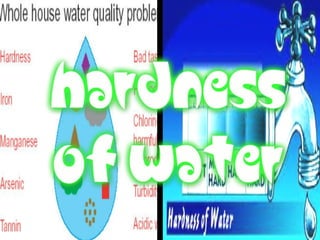Denunciar
Compartilhar

Recomendados
Recomendados
Mais conteúdo relacionado
Destaque
Destaque (9)
Palm Oil, Palm Kernel Oil Process - Fractions, Derivatives and Product Uses

Palm Oil, Palm Kernel Oil Process - Fractions, Derivatives and Product Uses
Semelhante a Chemistry
Semelhante a Chemistry (20)
Water chemistry using engineering chemistry UNIT-1.pdf

Water chemistry using engineering chemistry UNIT-1.pdf
Mais de Stuti Majmudar
Chemistry
- 2. E F F E C T S With hard water, soap solutions form a white precipitate (soap scum) instead of producing lather, because the 2+ ions destroy the surfactant properties of the soap by forming a solid precipitate (the soap scum). A major component of such scum is calcium stearate, which arises from sodium stearate, the main component of soap: 2 C17H35COO- + Ca2+ → (C17H35COO)2Ca
- 3. TYPES OF HARDNESS TEMPORARY HARDNESS PERMANENT HARDNESS Caused by the presence of dissolved bicarbonate chemicals. When dissolved these minerals yield calcium and magnesium cat ions and carbonate and bicarbonate anions . It can be removed by either boiling the water or by addition of lime through the softening process. Caused by the presence of calcium sulphate and magnesium sulphate which do not precipitate out while boiling. Ions causing permanent hardness can be removed by using a water softener or Ion exchange column.
